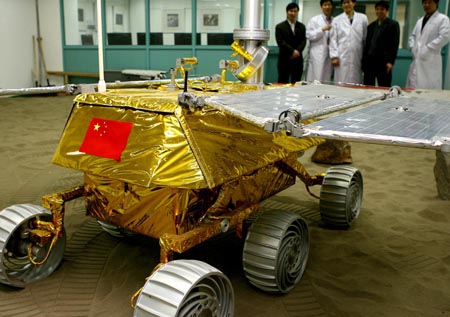China's first moon rover debuts in Shanghai
(Shanghai Daily)Updated: 2007-04-02 09:01
|
|
Shanghai has developed a prototype lunar rover it hopes will be chosen for China's first landing on the moon in 2012, researchers said over the weekend.
The remote-controlled vehicle MR-2 was unveiled on Saturday at a China-United Kingdom space technology seminar at the Shanghai Aerospace System Engineering Institute in Minhang District in the city's south.
The rover, which travels at an average speed of 100 meters per hour and is 1.5 meters high and weighs 200 kilograms, is similar to America's "Spirit," which landed on Mars.
"We want to make it better than the early US and Russian rovers," institute director Luo Jian said, without specifying the improvements.
He said engineers have spent the past four years developing the as-yet unnamed moon vehicle in a laboratory outfitted to mimic the lunar surface.
The rover is designed to take three-dimensional images, transmit real-time motion pictures and dig and analyze soil samples.
Luo said the rover can climb slopes, and its sensors can help it avoid bumping into obstacles.
Researchers are still refining the vehicle to ensure it can handle the moon's gravity, which is only one-sixth that of Earth's, and withstand intense cosmic rays and temperature differences that run between minus-180 degrees Celsius at night and 150 degrees in the day.
The biggest challenge for planners is energy supply because each "night" on the moon lasts for 14 Earth days, making solar power problematic.
Institute engineers said they are planning to install a nuclear power source to ensure the rover's constant operation during its mission 380,000 kilometers away from Earth.
The institute also plans to build a simulated lunar-environment laboratory complete with moon-type gravity and cosmic rays over the next few years to enhance the testing process.
Space institutes in Beijing and elsewhere in China are also working on their own rovers. It was not clear when China's space authority would make a final selection.
The country's lunar ambitions are set out in the "Chang'e Project," named after the Chinese moon goddess. It comprises three stages through 2017.
A lunar orbiter will be launched late this year; the remote-controlled lunar rover will sent up in 2012; and an unmanned return module will follow. Those steps are part of the preparations for a manned lunar voyage at some time beyond 2017.
|
||
|
||
|
|

